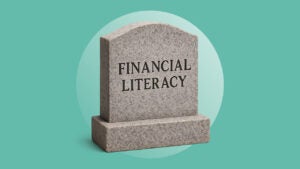Here’s how I’m trying to teach my two young daughters about money

As of December 2023, just half of all U.S. states have a standalone personal finance requirement in high schools, and even those that do are more likely to scratch the surface than to go really deep on the topic. For better or worse, most financial education takes place at home. But by and large, Americans aren’t great at discussing money matters, so many people end up learning via the school of hard knocks.
My financial education journey as a parent
I’m determined to do better by my daughters, who are 9 and 3. Certainly, that’s due in part to my professional life, as someone who reads and writes and speaks about money all day long. But this interest was rooted much further back.
In the late ‘90s, I took a personal finance course in high school. The dot-com boom (and later bust) made it a fascinating time to be putting together mock investment portfolios and making copious amounts of imaginary money gobbling up every hot tech stock. Of course, many of these dot-com darlings later plummeted, so there were many great lessons contained within this exercise. More than anything, it got me interested in CNBC and stock markets, and a lifelong love of personal finance was born.
My investing strategy these days is all about buying and holding index funds (considerably safer than chasing the next trendy IPO, but it definitely works). My favorite teaching tool for young investors is to point out that if you earn an average of 10 percent annually (in line with historical trends for major indices such as the S&P 500), your money doubles approximately every seven years. In this example, if you start at age 20, you have six doubling periods by age 62. In other words, a dollar invested at age 20 would become $64 a little over four decades later. That’s why Einstein dubbed compound interest the eighth wonder of the world.
Now that I have kids of my own, I feel compelled to pass along these and other personal finance lessons. As young as age 2 or 3, you can start teaching kids about money in terms of bills and coins. As in, if you give a store money, you can get groceries, toys, etc. We have a pretend cash register at home and have served many customers (mostly stuffed animals).
A couple summers ago, I helped my older daughter Ashleigh organize a lemonade stand/bake sale and she made about $50 in a single afternoon from friends, neighbors and other passersby. It can also be nice to introduce a charitable element to that sort of thing, perhaps instituting a “spend, save, give” framework to the money your kids earn.
Our brief attempt at giving an allowance
Around the same time, my wife and I agreed to start giving Ashleigh a weekly $3 allowance. We wrestled with this and still do, to be honest. I didn’t get an allowance as a kid. My parents said it was important to pitch in around the house simply as a member of the family and not with the expectation of being paid.
I mostly agree with that, but I was also intrigued by the idea of equating work with money and giving Ashleigh the opportunity to earn some spending money. Services such as Greenlight, GoHenry and other best money management apps for families support this and include features ranging from allowance and chore tracking to smart spending tools, investing, educational games and more.
I think an allowance can be a clever way around the “gimme, gimme” tendency that many kids have. For example, the next time they beg for a toy or souvenir, they can elect to pay for it out of their allowance. In part, I viewed the allowance as a predetermined allocation of cash that could be used for these extras.
Done right, I think an allowance can teach solid lessons about a work ethic and also about tradeoffs. Some kids are happy to spend mom and dad’s money on trinkets, but when they have to work for their discretionary purchases, they may no longer find them as worthwhile, so they have to decide what’s most important.
Ashleigh had some successes with her allowance, including the ability to buy some things she wanted and opening a bank account that still houses a small nest egg. However, her interest in the allowance has waned and now we’re looking for a new teaching tool.
Should we try investing instead?
I’ve been thinking for a while about building a mock stock portfolio with Ashleigh. It might be time to follow through on that. We could do it with truly fake money or maybe even put in a little real money to make it more interesting.
I think Ashleigh would enjoy picking and researching companies she knows, such as Disney and McDonald’s. If it goes well, this could teach her about how stocks represent small ownership shares in a business and how the value rises and falls along with the business’ performance and the overall state of the economy. Maybe we could even do a comparison between a handful of individual stocks and a broad market index fund.
Becoming a savvy shopper
I have also tried to teach Ashleigh about comparison shopping. She likes accompanying me to the grocery store, and I constantly talk about unit pricing — as in, the 16-ounce cereal that costs $6 is a much better deal than the 8-ounce box that costs $4.50.
We also talk about how it often makes sense to buy cheaper generic products since it’s basically the same stuff for less money (except for a few times when brand loyalty really seems to matter; I’ve never found a store-brand cereal I like but I happily buy generic spices, salad dressings and other things).
Building credit
When my daughters are a little bit older, I plan to add them as authorized users on my credit cards to help them build credit. I think it makes sense to do this around the same time they start driving — around age 16 or 17. They’ll still be living at home, but they’ll be more independent.
While you can build credit as an authorized user without even using the credit card, I think it’s a good idea to practice spending with plastic because it feels different — and often, less painful — than parting with bills and coins. Plus, digital transaction methods will continue to grow over time. I’m not sure my girls will ever write a check in their lifetimes, and cash’s influence seems to be fading with each passing year.
The bottom line
I view promoting financial literacy as an important parental task and look forward to continuing to experiment along with my wife and daughters. It’s important for parents to find age-appropriate ways to teach their kids about money. More than anything, it’s good to get these conversations going early and often.
Have a question about credit cards? E-mail me at ted.rossman@bankrate.com and I’d be happy to help.
Why we ask for feedback Your feedback helps us improve our content and services. It takes less than a minute to complete.
Your responses are anonymous and will only be used for improving our website.






